The Best SEO Analyzer Software and Tools for Your Website
When I first started in content marketing, I had somewhat of a Field of Dreams mentality to creating content. If I created it, the users would come.
How wrong I was.
So much of a content marketing plan’s success depends on how Google and other search engines see your content and where they rank it.
To get Google and other search engines to see your content as quality and rank it high, you have to get your house in order. Not only must content be in-depth, valuable, and meet user intent. It must also send the right signals to Google through backlinks, technical SEO, and proper content structure.
To make sure your site is ranking and staying ranked, there are a variety of tools you can use to plan, track, and analyze content.
We’ve rounded up our favorites to help you get your search engine optimization started.
Free SEO Tools
Let’s start with free SEO tools. If you’re just starting to dive into SEO, and you’re feeling your way through the myriad analytics you can collect, it’s a good idea to try a few free tools before you commit to something. These are also great tools for smaller brands with modest budgets.
Google Analytics (GA)
GA is a great all-around SEO tool that just happens to be free, too! To use it, you need to set up or sign into your Google account and create what they call a property using your site URL. Then, set up a reporting view, essentially letting Google know what data to report. Follow the instructions to add the tracking code to your site, and you’re ready to track!
Once you get the hang of it, you can track site and page rank, page views, time on page, backlinks, landing page traffic, keyword popularity, you name it. It’s worth taking a look at a few of Google’s tutorials to help you understand just how much you can analyze with GA.
MozBar
MozBar is a free Chrome extension from Moz. It lets you view page authority, domain authority, and link metrics in real time as you browse sites. The same metrics will appear in search engines for pages that show up when you search a particular keyword.

It also makes on-page keyword and content suggestions.
If you like to work on the fly, rather than spend time interpreting spreadsheets and graphs, this is a great extension to have in your toolbar.
Google Mobile-Friendly Test Tool
In March 2018, Google announced its mobile-first indexing initiative. According to Statista, more than half of all organic searches in 2018 were done via mobile, and there will be an estimated 221 million mobile search users by 2020.
Because so many people interact with the web via mobile, Google now indexes the mobile version of all sites before it indexes the desktop version. Sites with poor user experience on mobile are ranked low on their SERPs.
So checking your site’s responsive or mobile design is now a big part of SEO. Like every other part of SEO, Google doesn’t want to leave you in the lurch, so they created this free tool to let you see what users see (and what Google sees) on their mobile devices.
SEMRush
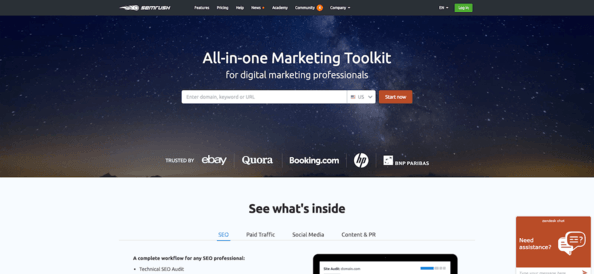
I’ve mentioned SEMRush before. It’s a great all-around SEO tool that lets you plan keywords, check and track your ranking, and check backlinks. You can also keep track of your traffic analytics and perform a site-for-site comparison with your competitors.
While they do charge a fee for full access, you are allowed up to 10 URL searches per email address for limited analytics, and they do have a 30-day free trial for their entire site.
When I teach digital and content marketing, I recommend this tool for my students’ analytics and SEO analysis assignments.
Keyword Planner Alternatives
A keyword planner helps you find short- and long-tail keywords to use in your content planning. But they can also help you analyze your existing content to ensure you’ve chosen the best keywords.
MarketMuse
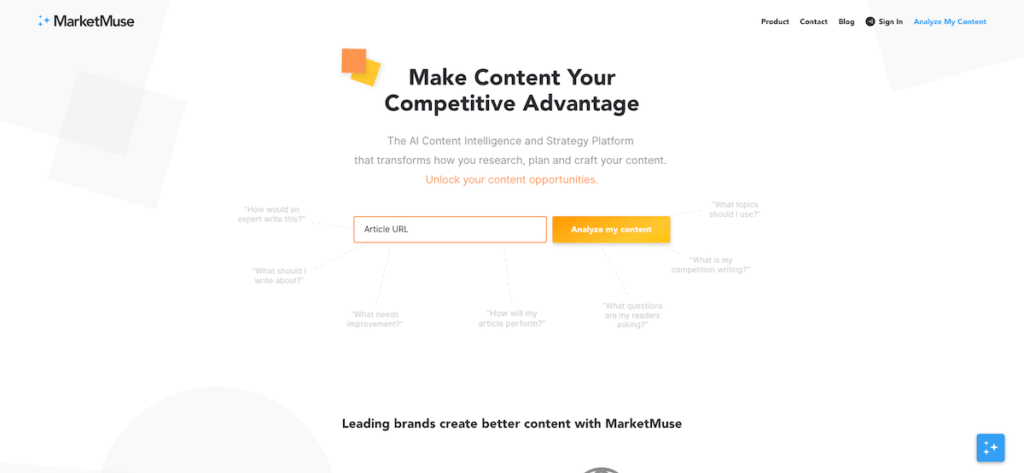
MarketMuse is a content optimization tool that enables you to take keyword research to another level. Most keyword tools can only provide keyword variants.
Usually, the list includes search volume estimate, but this post about keyword volume shows why you shouldn’t be so fixated on this metric. Plus, a list like this doesn’t help when it comes to writing about the topic.
MarketMuse uses advanced topic modeling to create a list of semantically related words that are useful for creating in-depth content on a specific topic. MarketMuse also uses this data to identify content gaps within your content or the competition. Here’s part of list MarketMuse provides for the focus topic.
Here’s the difference between MarketMuse and a typical keyword research tool, using the same keyword content marketing.

On the left, we see a MarketMuse partial list of topics semantically related to the focus topic “content marketing,” ordered by relevance .On the right, is the list from a typical keyword tool showing variants of the keyword “content marketing.”
While the MarketMuse list provides useful insight for writing about the topic, the same can’t be said for the keyword list.
Google and other search engines now look beyond the number of times a keyword appears in your content. It uses bots and real people to make sure the content you create for the keyword truly answers the question the user had when they plugged in that search term.
With MarketMuse’s semantic analysis, you can make sure your content is doing just that.
Google Keyword Planner
Google’s Keyword Planner tool is attached to their Google Ads tool. It’s meant to help advertisers choose competitive keywords within their budget.
But it can be used by savvy content marketers, too. Keywords with a higher cost per click are obviously the most popular keywords, while a lower CPC indicates a less-popular keyword.
Pro Tip: If you are a smaller brand, or you’re looking for domain authority, going with a less-popular keyword may be the best option. That way, your site doesn’t get lost in a sea of other websites competing for the same keyword. This is particularly true if a big brand like Nike or Walmart already has domain authority on a keyword.
KeywordTool.io

KeywordTool.io markets itself as an alternative to Google Keyword Planner. According to the site, it uses a search engine’s autocomplete function to generate a list of long-tail keywords.
With the free version, you type in a keyword, and KeywordTool.io gives you a list of 750+ related long-tail keywords. The paid version gives you a bigger list.
You can search Google, Bing, Youtube, and several other domains to find the best keyword fit for each. And it covers 82 different languages.
BuzzSumo

BuzzSumo is another all-in-one tool that goes way beyond merely showing you a list of popular keywords. You can search popular topics by a particular time frame. You can see how themes resonated on different platforms. And you can even see the most shared content formats and domains for a specific topic.
Finally, you can plan for long- or short-form content based on a keyword or topic.
Rank-Tracking Software
Most content strategists have a love-hate relationship with rank tracking software. When your pages are ranking high, you feel good. When they’re not ranking so well, you feel less good.
The problem with rank tracking software is that they don’t provide any context or insight. The numbers change, but you don’t know why.
Alexa
The free version of Alexa lets you see a site’s overall global and national rank and whether that rank has fallen or risen.

Further down, you get some basic site engagement statistics, like bounce rate and time on page. You can also see where users are coming from.
Finally, you can see which sites are directing traffic to you, which keywords your ranking for, and how much of your traffic is from search engines.
Of course, the paid version gives you much more in-depth analytics, but the free version is a good way to see your general standing online.
CanIRank

CanIRank targets small businesses and startups, two types of businesses that typically have a hard time ranking on keywords.
According to the company site, it tracks your page ranking and makes suggestions on how to improve it using AI. It can also analyze the pages that are ranking better than you and tell you why that’s the case.
Finally, it can give you instructions on how to fix your ranking, or you can get help from an SEO expert through their site.
RankTrackr

RankTrackr is for SEO professionals who want to get into the nitty-gritty of their ranking analytics.
Users can filter ranking statistics by geographical region right down to a specific zip code. They can also look at the historical performance of a site.
This tool generates all kinds of reports and insights that really help a brand focus their SEO efforts on the right audience and the right topics.
Google Search Console
You probably see a pattern here. For every kind of SEO analysis, there’s most likely a free tool from Google.
Google Search Console is targeted toward web developers, in particular, but it can help you track your site and page rankings.
It’s basically the same report you see in Google Analytics. But in Google’s search console, you can see the actual search query users are plugging into Google and how Google is interpreting the content on your site, which means you get some helpful insights on how to fix ranking problems.
Moz

Moz recently acquired STAT and in-depth SERP tracking tool that allows big brands to track a large number of pages and keywords. They can get daily stats on their own performance, as well as the performance of their competitors.
This is in conjunction with Moz’s other content and SEO analysis tools that help brands rank.
Backlink Analysis Tools
When determining domain and page authority, Google looks at the kinds of backlinks your site has. A backlink is a link from another site that points to your pages or content. If you have a lot of backlinks from trusted sites, Google sees you as an authority in your domain and ranks you higher.
Linkody

This tool lets you track everything about your backlinks. You can see when you gain or lose them and enables you to disavow links to bad sites. You can also check your redirects, outgoing links, and anchor text.
Finally, you can keep track of your link analytics and optimize your landing pages to gain those valuable backlinks.
But the elegant thing about Linkody is that it also provides analytics from Moz and Alexa, and it integrates with your GA.
This is like a one-stop shop for your links and analytics.
Majestic SEO
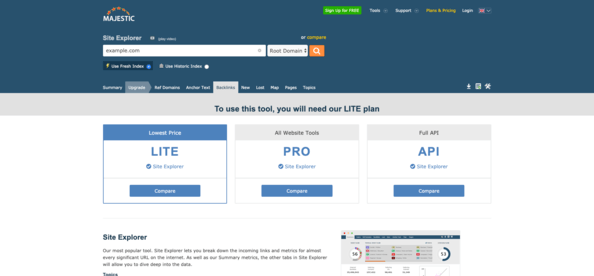
Among other features, Majestic SEO has a full backlink checker that lists all backlinks pointing to your site. That includes new ones and old ones, as well as the anchor text the backlinks are using. You can see which ones have stopped pointing to you recently and which categories you are being referenced for.
Finally, you can see all the URLs that point to you.
The neatest thing is the world map, where you can see where on Earth the domains that point to you are coming from.
Ahrefs
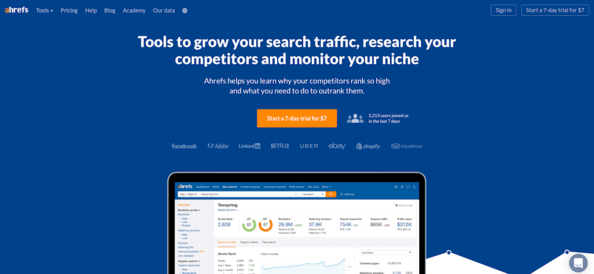
Ahrefs has a vast backlink database. According to their site, they are the second most active web crawler behind Google. And it’s updated every 15 minutes.
There’s a free version of the software, but to get really in-depth you can try the enterprise version for seven days for a dollar a day.
Technical SEO Software
Finally, there are tools to help you manage the technical piece of your SEO. Google and other search engines look beyond your content and your keywords to rank your site. They’re also looking at your metadata, alt tags, canonicalization, site structure, and site map, among other things.
They use all of these HTML codes and tags to “read” your site and determine if it’s a quality or spammy website.
Screaming Frog
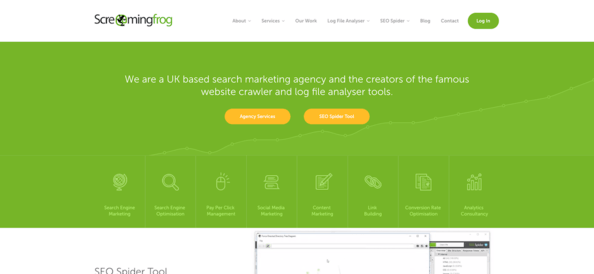
Screaming Frog is the most thorough web crawler I’ve ever seen. It can give you all kinds of technical SEO information about your site, including broken links, redirects, backlinks, meta tags, and image size.
It can also find duplicate content on your site and help you generate an XML sitemap, two things that have a significant effect on Google ranking.
The free version will crawl up to 500 URLs, while the paid version lets you crawl an unlimited number of URLs.
Google Web Developer Toolbar
This is a very technical tool that helps you check alt tags for images, no-indexing, and canonicalization and validate your optimization for mobile.
The Google Web Developer Toolbar is for someone who can really dive into the backend coding of your site and fix those hidden HTML tags that help Google read your site.
There’s a long checklist of elements you have to keep in mind when tracking and analyzing SEO. But you don’t have to do it alone. Check out any of the tools above to help you optimize your content and get it ranked.
What you should do now
When you’re ready… here are 3 ways we can help you publish better content, faster:
- Book time with MarketMuse Schedule a live demo with one of our strategists to see how MarketMuse can help your team reach their content goals.
- If you’d like to learn how to create better content faster, visit our blog. It’s full of resources to help scale content.
- If you know another marketer who’d enjoy reading this page, share it with them via email, LinkedIn, Twitter, or Facebook.
Laurie is a freelance writer, editor, and content consultant and adjunct professor at Fisher College. Her work includes the development and execution of content strategies for B2B and B2C companies, including marketing and audience research, content calendar creation, hiring and managing writers and editors, and SEO optimization. You can connect with her on Twitter or LinkedIn.